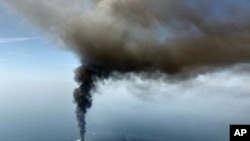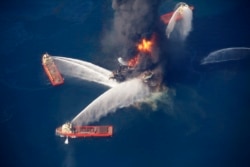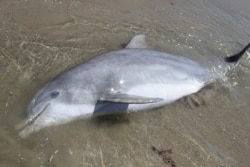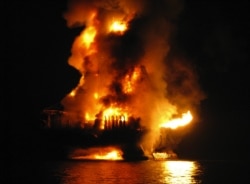Ten years after the Deepwater Horizon oil rig explosion killed 11 workers, injured 17 more and leaked 800 million liters of crude oil into the Gulf of Mexico, ecological devastation has proved hard to reverse and made the oil industry determined to avoid a costly repeat.
Scientists say large swaths of the Gulf may never be the same. London-based oil company BP, which leased the doomed rig and suffered one of the worst black eyes in corporate history, insists the same can be said of itself.
“The Deepwater Horizon accident changed our company forever,” Jason Ryan, BP’s director of public affairs, told VOA. “We’re committed to helping to restore the Gulf, and to becoming a safer company.”
Such statements aren’t just talk according to Eric Smith, associate director of Tulane University’s Energy Institute in New Orleans.
“Oil companies are spending more money on offshore drilling equipment that is safer than ever before,” he said, “and the staff operating that equipment is better trained.”
In the decade since the disaster, BP has set aside $69 billion to help repair tens of thousands of square kilometers in the Gulf region damaged by the spill. Despite the expenditure, scientists continue to document ways in which the largest offshore oil spill in American history harmed one of the world’s most productive aquatic ecosystems.
“A lot of progress has been made in 10 years,” said Dustin Renaud, communications director for the environmental nonprofit, Healthy Gulf. “There’s an unprecedented amount of money being spent on repairing the Gulf of Mexico, but there’s also an unprecedented amount of damage that needs repairing.”
He cited the underwater site of the spill as one particularly heartbreaking example.
“We’re seeing the old oil around the well seems to be attracting communities of crabs,” he said. “But a lot of the crabs are deformed because oil is poison. So you have these deformed crabs coming to mate, but when they try, they’re too sick to reproduce. That kind of stuff wasn’t happening before the spill and it won’t be easy to fix.”
An Explosion Rocked the Gulf
“I’d never been on as many conference calls in my life as I was during those first few weeks after the Deepwater explosion,” David Muth, director of the National Wildlife Federation’s Gulf restoration program, said to VOA.
While environmentalists worked around the clock to protect coastal areas, BP frantically attempted to cap a wellhead some 1500 meters below the surface.
As days went by and oil continued to pour into the Gulf, it became clear to Muth and others that the ecological impact would be severe and long lasting.
“The more I heard, the worse it got,” Renaud said.
BP made a series of efforts to contain the leak, from deploying a four-story tall underwater balloon to shooting “junk shots” -- a mix of golf balls, rubber balls and other debris -- into the ruptured well.
“It seemed like every day they were trying something different,” Smith recalled.
Oil leaked into the Gulf for 87 days, during which time a two-story-tall contraption known as a capping stack was built from scratch to seal the well.
Renaud faulted BP for not having a capping stack on hand and said the amount of time it took to stop the leak felt like a betrayal by the company, which had assured environmentalists and regulators for years that drilling at lower depths could be done safely.
“They always told us that whatever the spill and wherever the spill -- they’d be able to stop it in 24 hours,” he said. “This one took 87 times that, and our ecosystem is still paying for it.”
Altered Ecosystem
Oil reached more than 2,000 kilometers of shoreline stretching across Texas, Louisiana, Mississippi, Alabama and Florida.
More than 100,000 sea birds died from oil exposure along with tens of thousands of sea turtles. Dolphin deaths recorded in the Gulf have more than tripled in last decade. One of the most endangered sub-species in the world, the Gulf of Mexico Bryde’s whales, saw its numbers decline 22% and today are thought to number fewer than 100.
For all that has been documented, Muth warned what isn’t yet known is equally worrying.
“We all love these charismatic mega-fauna-like dolphins, but that’s really just the tip of the iceberg,” he said, adding that the full extent of the devastation on the ocean floor may never be fully understood.
“There’s species at the bottom of the Gulf that we only learned existed in the last few decades, so we lack the baseline data to say how badly they’ve been damaged,” he said. “And then there’s species farther from shore we don’t see very often. If a type of dolphin that lives out in the middle of the Gulf doesn’t wash ashore, we don’t know it died from oil.”
An Uncertain Industry
The Gulf’s ecosystem isn’t alone in undergoing change after the oil spill.
“It was a much rosier picture for Gulf of Mexico offshore drilling 10 years ago,” Smith said, noting the Obama administration imposed a moratorium on new drilling after the spill. The administration also sought increased inspection of blowout preventers, a component designed to shut off the oil flow during an emergency that failed on the Deepwater Horizon.
Many Obama-era executive environmental actions have been rolled back by the Trump administration. Conservation organizations have responded with lawsuits to maintain restrictions and safety measures.
“These are the rules meant to stop another BP oil spill from happening,” Renaud said. “Just because we haven’t had a major oil spill in 10 years doesn’t mean it’s time to start ‘Drill, baby, drill’-ing again.”
Decade of Change
Despite disagreements, environmentalists and energy advocates concur that unprecedented efforts have been made to repair the Gulf of Mexico’s treasured ecosystem.
“Louisiana, alone, is spending a billion dollars on coastal restoration projects, and a lot of that money has come from BP,” Muth says. “We won’t be able to do everything we need or want to do, but there’s no denying that kind of money is unheard of.”
Oil companies, meanwhile, have clear incentives to prevent future spills, according to Smith, who says safety standards have been raised for offshore drilling to protect against another disaster -- not just in the Gulf, but around the world.
“The equipment is just much safer today,” Smith said. “In part because of the [BP] spill, the strictest standards are [found] in the Gulf of Mexico and the North Sea.”
The Tulane professor points to the creation of industry-sponsored organizations like the Marine Well Containment Company to maintain an inventory of specialized equipment - including the capping stacks BP lacked in 2010 - to quickly close a ruptured undersea well.
Five capping stacks currently sit in wait at an MWCC facility near Corpus, Christi, Texas. Each is intended to plug an oil leak at different ocean depths, pressures and temperatures.
At the same time, Smith warns that offshore drilling can never be completely free of risk.
“I think we’ve made it so that a situation exactly like Deepwater can never happen again,” he says. “But I think it was Mark Twain who said that, while history doesn’t repeat itself, it often rhymes. We can never be sure what the next disaster will be, but the oil we get from the Gulf is too important to our country’s energy supply to abandon. It’s our job to learn from past mistakes and to try to be ready for the next one.”









